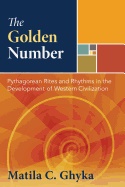The Golden Number, or Phi (Ö), is a geometric ratio found throughout nature, often underlying the dimensions of objects considered especially beautiful. Simplified as 1.618 and symbolised by the Fibonacci sequence, the Golden Number represents the unique relationship within an object where the ratio of a larger part to a smaller part is the same as the ratio of the whole to the larger part. It appears in the proportions of the human face and body as well as in the proportions of animals, plants and celestial bodies.
Called the divine proportion by the monk Fra Luca Pacioli, whose book on the subject was illustrated by Leonardo da Vinci, Phi's use in art and architecture goes back at least to the mystical mathematics of Pythagoras and his followers in the sixth century BCE. The perfect synthesis of spiritual and material, it can be found in the measurements of the sacred temples of Egypt, Ancient Greece and Mediaeval and Renaissance Europe.
Presenting Matila Ghyka's classic treatise on the Golden Number for the first time in English, this book reveals the many ways this ratio can be found not only in the organic forms of nature - such as in the spirals of shells or the number of petals on a flower – but, also, in the most beautiful and highest creations of humanity. One of the most important concepts of sacred geometry, its mysteries were passed down in an unbroken line of transmission from the Pythagorean brotherhoods through the mediaeval builders' guilds to the secret societies of 18th-century Europe. Ghyka shows how the secrets of this divine proportion were sought not merely for their value in architecture, painting and music, but, also, as a portal to a deeper understanding of the spiritual nature of beauty and the hidden harmonies that connect the whole of creation.
· Reveals how the Golden Number, Phi, underlies the spiritual nature of beauty and the hidden harmonies that connect the whole of creation
· Explains how the spiritual mysteries of the Golden Number were passed down in an unbroken line of transmission from the Pythagorean brotherhoods through the mediaeval builders' guilds to the secret societies of 18th-century Europe


